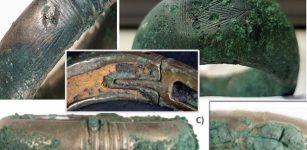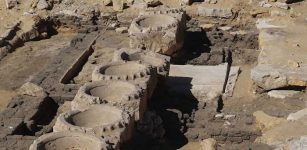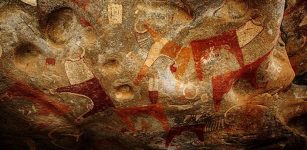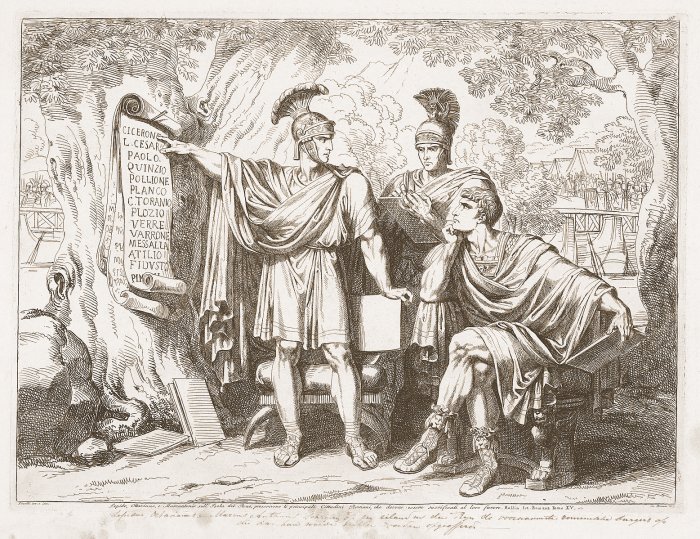Triumvirates In Ancient Rome: Power Struggle, Intrigue And Ambush
Conny Waters - AncientPages.com - A triumvirate (in Latin' tre viri' - three-man - or 'triumviri') was a board of three officials who shared a position of authority or power in ancient Rome.
Lepidus, Octavian and Mark Antony make a list of names of the most important Romans, whom they can execute with impunity and expropriate their property (the second triumvirate). Image credit: Rijksmuseum -Credit line: Schenking van J.J. de Man, Ede - CC0 1.0 DEED
A political agreement between these statesmen enabled them to govern together so that "nothing in the republic could happen without their consent."
The "First Triumvirate," also known as - the alliance of 'three' - was an unofficial arrangement made in 60 BC by Gnaeus Pompeius Magnus (Pompey' the Great'), Gaius Julius Caesar, and Marcus Licinius Crassus.
These three strong political leaders could control the Roman political system and support each other to achieve their goals.
This "first alliance of three" lasted until the death of Crassus, who started an unwarranted invasion of Parthia and was killed in 53 BC during the Battle of Carrhae (now Harran Southeastern Anatolia, Turkey.
Caesar's triumphant military campaigns in Gaul and Pompey's persistent pursuit of more alliances to weaken Caesar unintentionally paved the way for a conflict. Pompey was defeated at the Battle of Pharsalus in 48 BC and sought refuge in Ptolemaic Egypt, where the courtiers of Ptolemy XIII assassinated him. The triumvirate fell apart because of a battle and ambush. Caesar ruled alone until his assassination in the Senate in 44.
The Second triumvirate was created in 43 BC by a Roman law, 'lex Titia.'
It granted Mark Antony, the young Caesar (the future Augustus), and Lepidus unlimited power for five years.
The triumvirate was later renewed in 38 BC. Unlike the so-called First Triumvirate, a private arrangement among three men, the Second Triumvirate was a legal instrument that created a formal legal framework to empower the three triumvirs with practically absolute power.
They had the authority to enact or abolish laws and issue judicial penalties without following due process or allowing for appeals, and they were responsible for appointing all other officials.
Additionally, they divided the Roman world into three distinct provinces.
This agreement concluded in 43 BC between Octavian, Marek Antony, and Marek Lepidus, was established to sort out the situation in Rome after the death of Gaius Julius Caesar and punish his assassins.
The Augustus of Prima Porta, 1st century AD, depicting Augustus, the first Roman emperor. Image credit: Joel Bellviure - CC BY-SA 4.0
The Second triumvirate differed from the first in that it was a legal entity expressly approved by the Senate rather than a private contract between strongmen. However, the second suffered the same fate as the first.
Many internal quarrels and jealousy led to its weakening and downfall.
Lepidus was the first to fall. After a power struggle against Octavian, he was stripped of all his offices except Pontifex Maximus in the year 36 and later banished to a remote island. Antony, on the other hand, spent four decades in Egypt living with Cleopatra and progressively distancing himself from Rome's political power plays. He met a crushing defeat at the 31st Battle of Actium.
It was a devastating loss, and Antony took his own life.
Octavian changed his title to Augustus in 27 AD and became the first emperor of Rome. The situation in ancient Rome began to change; the power of the Senate and its consuls was broken. The Roman Empire began its almost half-millennium influence on the Mediterranean world.
Among several different triumvirates, there was, for example, 'tresviri monetales 'in charge of the mint for Rome and Italy during the republic and the empire.
Another one, 'Tresviri epulones,' was initially a board of three priests created in 196 BC to manage the banquet of Jupiter, the critical event in the Ludi Romani and Ludi Plebeii festivals.
Written by Conny Waters - AncientPages.com Staff Writer
Copyright © AncientPages.com All rights reserved. This material may not be published, broadcast, rewritten or redistributed in whole or part without the express written permission of AncientPages.com
Expand for referencesReferences:
Clifford A. The First Triumvirate Of Rome
Zoch Paul. A. Ancient Rome: An Introductory History
Balsamo W. The First Triumvirate Of Rome
More From Ancient Pages
-
 Intriguing Hoard Of Bronze Age Bracelets From Brittany, France Remains An Archaeological Puzzle
Featured Stories | Jan 30, 2024
Intriguing Hoard Of Bronze Age Bracelets From Brittany, France Remains An Archaeological Puzzle
Featured Stories | Jan 30, 2024 -
 Unexplained Disappearance Of East Balkan Civilizations – Scientific Disagreement – Part 2
Ancient Mysteries | Apr 30, 2018
Unexplained Disappearance Of East Balkan Civilizations – Scientific Disagreement – Part 2
Ancient Mysteries | Apr 30, 2018 -
 Glooskap (Gluskap): Mythical Hero Who Defeated Evil Sorcerers And Demon Followers
Featured Stories | Jan 25, 2016
Glooskap (Gluskap): Mythical Hero Who Defeated Evil Sorcerers And Demon Followers
Featured Stories | Jan 25, 2016 -
 Abu Erteila’s Lost Temple And The Meroitic Empire: New Discoveries Shed Light On Nubian Civilization
Archaeology | Jan 14, 2016
Abu Erteila’s Lost Temple And The Meroitic Empire: New Discoveries Shed Light On Nubian Civilization
Archaeology | Jan 14, 2016 -
 Seven Gods Of Happiness – Bring Luck, Prosperity And Health In Japanese Folk Belief
Featured Stories | Jun 29, 2020
Seven Gods Of Happiness – Bring Luck, Prosperity And Health In Japanese Folk Belief
Featured Stories | Jun 29, 2020 -
 Ancient Mesopotamian Artifacts Unearthed In Kurd Qaburstan Fill A Historical Gap
Archaeology | Jan 15, 2025
Ancient Mesopotamian Artifacts Unearthed In Kurd Qaburstan Fill A Historical Gap
Archaeology | Jan 15, 2025 -
 Unusual Iron Age Cemetery Discovered In Dorset, UK
Archaeology | Jul 11, 2022
Unusual Iron Age Cemetery Discovered In Dorset, UK
Archaeology | Jul 11, 2022 -
 Satellite Images Revealed Lost Ancient Irrigation System In Desert-Like Region Of China
Ancient Technology | Jan 6, 2018
Satellite Images Revealed Lost Ancient Irrigation System In Desert-Like Region Of China
Ancient Technology | Jan 6, 2018 -
 Huge Subterranean Pre-Columbian Shaft Tombs In Tierradentro, Colombia
Featured Stories | Apr 28, 2021
Huge Subterranean Pre-Columbian Shaft Tombs In Tierradentro, Colombia
Featured Stories | Apr 28, 2021 -
 Undeciphered Ancient Symbols On Boulders In Pennsylvania And New England Could Be An Ancient Diary Of Forgotten Civilizations And Events
Featured Stories | Jul 4, 2024
Undeciphered Ancient Symbols On Boulders In Pennsylvania And New England Could Be An Ancient Diary Of Forgotten Civilizations And Events
Featured Stories | Jul 4, 2024 -
 4,500-Year-Old Lost ‘Sun Temple’ Dedicated To God Ra Unearthed In Abu Gorab Necropolis
Archaeology | Aug 4, 2022
4,500-Year-Old Lost ‘Sun Temple’ Dedicated To God Ra Unearthed In Abu Gorab Necropolis
Archaeology | Aug 4, 2022 -
 Mysterious Disappearance Of Explorer Peng Jiamu In Lop Nur – The Wandering Lake
Featured Stories | Dec 20, 2018
Mysterious Disappearance Of Explorer Peng Jiamu In Lop Nur – The Wandering Lake
Featured Stories | Dec 20, 2018 -
 Whose Ancient Burials Are Hidden Inside The Vatican City’s Walls?
Archaeology | Mar 11, 2021
Whose Ancient Burials Are Hidden Inside The Vatican City’s Walls?
Archaeology | Mar 11, 2021 -
 Tuonela – The Land Of The Dead In Beliefs Of Ancient Finnish People
Featured Stories | Nov 9, 2021
Tuonela – The Land Of The Dead In Beliefs Of Ancient Finnish People
Featured Stories | Nov 9, 2021 -
 Discovery Of Fortified Villages And Earthworks Re-Writes Ancient History Of Amazon
Archaeology | Mar 29, 2018
Discovery Of Fortified Villages And Earthworks Re-Writes Ancient History Of Amazon
Archaeology | Mar 29, 2018 -
 Surprising Discovery – Large Piece Of Egyptian Blue Found In Domus Aurea, Emperor Nero’s Palace
Archaeology | Feb 11, 2025
Surprising Discovery – Large Piece Of Egyptian Blue Found In Domus Aurea, Emperor Nero’s Palace
Archaeology | Feb 11, 2025 -
 Magnificent Meteora And ‘Suspended In The Air’ Greek Monasteries
Featured Stories | May 5, 2021
Magnificent Meteora And ‘Suspended In The Air’ Greek Monasteries
Featured Stories | May 5, 2021 -
 Somalia’s Legacy: Laas Geel Caves Covered With At Least 5,000-Year-Old Paintings
Civilizations | Oct 18, 2018
Somalia’s Legacy: Laas Geel Caves Covered With At Least 5,000-Year-Old Paintings
Civilizations | Oct 18, 2018 -
 Crypts, Coffins, Artifacts And Wooden Church Remains Under The Floor Of Basilica In Poland
Archaeology | Mar 5, 2018
Crypts, Coffins, Artifacts And Wooden Church Remains Under The Floor Of Basilica In Poland
Archaeology | Mar 5, 2018 -
 1.3-Million-Year-Old Stone Age Axe Discovered In Morocco Pushes Back The Start Sate Of Acheulian Technology In North Africa
Archaeology | Jul 30, 2021
1.3-Million-Year-Old Stone Age Axe Discovered In Morocco Pushes Back The Start Sate Of Acheulian Technology In North Africa
Archaeology | Jul 30, 2021



